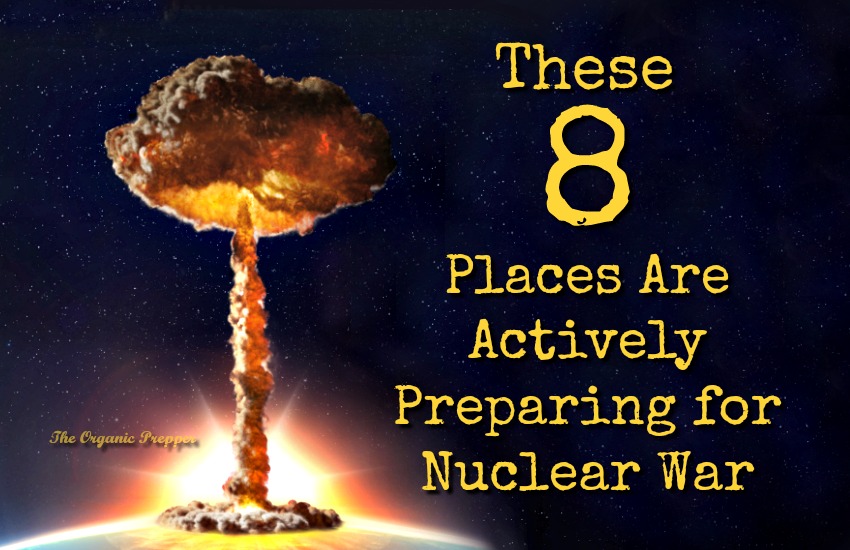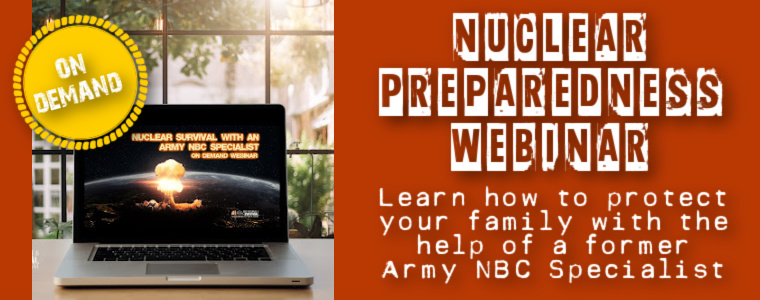If you're new here, you may want to subscribe to my RSS feed. Thanks for visiting!
By Daisy Luther
Everywhere, it seems like officials are actively preparing for the possibility of nuclear war.
Tensions are high in practically every corner of the world but somehow, despite the proliferation of imminent threats, many people are still blithely unaware of the hell that could be unleashed.
Due to tensions between the US and North Korea, the world is frantically preparing for the possibility of a nuclear attack. The US, China, Russia, North Korea, and South Korea have all shown force with bombers and destroyers, and it seems that it will only be a matter of time before one incident sparks a cascading explosion.
The governments of these 8 places are making preparations, but they’ll be to little avail if people don’t participate and just expect to be rescued.
1) South Korea
In South Korea, their government has urged citizens to get prepared for war, and prepping is becoming mainstream for North Korea’s nearest neighbor and sworn enemy.
The government of South Korea is making every effort to turn its citizens into a country of survivalists. With the ever-increasing threats from the North, South Korean preppers are becoming mainstream, instead of a quirky fringe element…
The South Korean President isn’t taking this lying down. “In case North Korea undertakes provocations against us or our ally, we have the power to destroy (the North) beyond recovery.” This threat most likely will not please the Dear Leader of North Korea, so it’s probably safe to predict even greater hostilities on the horizon.
The South Korean Ministry of Public Administration and Security has issued guidelines for a variety of attacks to their citizens due to the ever-increasing risk of an attack by North Korea…
…An article published in the South Korean Times states, “The number of doomsday pessimists is rapidly growing here, as is shown from the number of relevant YouTube videos and their views.”
The article goes on to describe a video by a popular female comedian that teaches watchers how to create a bug-out bag. But that’s not all. South Korean preppers are becoming mainstream. (source)
2) China
A Chinese newspaper from an area that shares a border with North Korea published a series of articles advising people how to prepare for a strike.
Bloomberg summarized the advice:
The Jilin Daily — the government newspaper of Jilin province on North Korea’s northeastern border — published articles on page 5 explaining how nuclear weapons work and the damage they cause. The paper used cartoons to offer advice on what residents can do about radiation exposure and provided instructions on how to respond during an attack.
One article listed essential items for emergency kits, including fire extinguishers and breathing masks. Another warned that air raids could mean nuclear, chemical and biological attacks, and used the 1945 atomic bombing of Hiroshima as an example.
3) Japan
Millions of people in Japan have taken part in (or soon will) nuclear attack evacuation drills, and the Prime Minister is urging local authorities to designate the best sturdy, underground sites to be used as potential shelters.
…Tokyo isn’t the first city to conduct these types of large-scale drills: Towns facing the Korean Peninsula have conducted similar drills in recent months.
The national and city governments are to carry out a series of exercises between January and March to prepare for a potential attack on Tokyo, the Sankei Shimbun newspaper reported, the first time that a major Japanese city will have carried out responses to a simulated attack.
Towns facing the Korean Peninsula have in recent months conducted similar drills, with residents instructed to seek shelter in response to sirens warning of an imminent missile strike.
Prime Minister Shinzo Abe has called on local governments throughout the country to identify underground facilities or buildings that are sufficiently sturdy to withstand a missile attack and to designate those facilities as shelters. source()
But it isn’t just Asia that is preparing for the possibility of a nuclear strike.
4) Australia
Australia recently received a warning from North Korea, calling the country a “vassal” of the United States.
5) Hawaii
Hawaii recently tested their nuclear sirens that have not been used since the 1980s. The island is the closest American state to Norht Korea, which makes it geographically vulnerable.
But here’s the bummer about the siren test. They were going for 20 whole minutes and hardly anyone even noticed them.
It’s hoped that the 385 sirens dotted around Hawaii will give residents and tourists a 20-minute warning if North Korean nuclear missiles are inbound.
But the sirens, which have been silent since the Cold War, were barely heard in the busy tourist areas of Waikiki, where most people obliviously went about their day.
…Disturbed by the underwhelming results of the tests, officials are now investigating whether the sirens were operating as they are supposed to. (source)
One of my dearest friends lives in Hawaii and has attended the nuclear preparedness meetings that have been held on Maui. According to her, hardly anyone shows up. No one is interested.
With that in mind, one must wonder if the issue with the lack of response to the nuke siren is one of decibels or one of cognitive dissonance.
6) Guam
As a US territory and the closest to North Korea, Guam could find itself in the crosshairs. Officials have issued guidelines to all its residents to prepare them for the possibility of a nuclear strike. (Here’s a link to the fact sheet.)
- “Make a list of potential concrete shelters near your home, workplace or school.”
- “Do not look at the flash or fireball — It can blind you.”
- “Lie flat on the ground and cover your head. If the explosion is some distance away, it could take 30 seconds or more for the blast wave to hit.”
- “When possible, take a shower with lots of soap and water…do not scrub or scratch the skin.”
- “Do not use conditioner in your hair because it will bind radioactive material to your hair.”
7) The US Mainland
Here on the mainland, California is making preparations, but one notable factor is that residents should not expect help from the government any time soon should such a catastrophe occur. (This, of course, is something that preppers have known for a long time and is clearly evidenced in the slow response to Puerto Rico.)
It also warns of the difficulties government authorities would likely encounter in dealing with the aftermath of a blast. The public will need to evacuate, the report says, but with “limited understanding of radiation risks, they will experience high anxiety and may be non-compliant…”
“…The consequences of a nuclear attack in Southern California would be catastrophic,” the report says. “Nonetheless, government entities and first responders are expected to remain operational to preserve human life, maintain order, and aid in the recovery process.”
The report, which is largely directed at local, state, and federal agencies and first responders located in the Los Angeles region, notes that the federal government will likely be of limited help immediately after a nuclear blast.
“[T]here will be no significant federal assistance at the scene for 24-72 hours following the attack,” the bulletin says. (source)
The Pentagon is planning missile defense bases along the coast.
Congressman Mike Rogers, who sits on the House Armed Services Committee and chairs the Strategic Forces Subcommittee which oversees missile defence, said the Missile Defense Agency (MDA) was aiming to install extra defences at West Coast sites.
“It’s just a matter of the location, and the MDA making a recommendation as to which site meets their criteria,” the Alabama Congressman and Republican said.
When asked about the plan, MDA Deputy Director Rear Admiral Jon Hill said in a statement: “The Missile Defense Agency has received no tasking to site the Terminal High Altitude Air Defense System on the West Coast.”
The MDA is a unit of the US Defense Department. Congressman Rogers did not reveal the exact locations the agency is considering but said several sites are “competing” for the missile defense installations. source()
The goal, of course, is to shoot down the missiles before they can land in the United States and cause untold damage and death tolls. It may not be that easy though. Alarmingly, several experts have raised concerns about our ability to shoot down nukes before they hit.
8) Russia
Russia has been preparing for nuclear possibilities for quite a while now. Last year, it was reported that Russia was building fallout shelters all over the country and that 40 million citizens participated in a defense drill shortly before the US election, when tensions were running high over Syria.
But it didn’t end with the election because now Russia is up to its eyeballs trying to defuse the US/North Korea situation. Russian president Vladimir Putin recently received a letter from Kim Jong Un that stated they could launch an attack on the US “at any day” and could reach the mainland.
As well, Russia has voiced concerns about the animosity with NATO and recently drilled for the possibilities of nuclear or biological attacks. Russia has alleged that the US and Europe are developing nuclear weapons use procedures at their borders.
Preparing for a scenario in which Russia was attacked by “weapons of mass destruction by a hypothetical enemy,” soldiers were deployed in hazmat suits and gas masks.
Units specializing in chemical weapons were deployed in the Krasnodar and Stavropol regions, while at least 100 personnel in the neighboring Rostov region launched a parallel decontamination drill on Monday. It followed similar exercises held by Russian overseas troops in nearby Armenia over the weekend.
Also deployed were mobile laboratories and radioactive- and chemical-tracing reconnaissance vehicles capable of quarantining, assessing and potentially eliminating a chemical or nuclear threat.
In recent weeks, Russia’s nuclear-capable forces practiced missile launches and flyovers in apparent offensive measures for a conflict scenario. (source)
Here is what would happen if a 10 kiloton nuclear strike occurred.
As I have written numerous times, if you aren’t at Ground Zero, a nuclear strike is very survivable. It isn’t one of those situations like The Road, where the whole world is a nuclear wasteland and people start eating each other to survive.
(This is an excerpt from my article, How to Prepare for a Nuclear Attack.)
Contrary to popular belief, a nuke won’t kill everyone within hundreds of miles. If you aren’t in the immediate blast radius, a nuclear strike is absolutely survivable.
The one-mile radius around the blast will be virtually unsurvivable. Within two miles, people will suffer 3rd-degree burns from the intense wave of heat.
If you are within two miles of the blast, the winds will be coming at about 600 miles per hour. This will take down buildings and cause a tremendous amount of pressure. Some experts recommend that you keep your mouth open to try and reduce the pressure on your eardrums. Looking at the blast could cause permanent blindness.
According to the DHS (source), 10 kilotons is the approximate size of nuclear weapon we could expect.
- Nearly everyone within a half-mile radius of the point of impact would die and most of the buildings would be demolished. This would be considered Ground Zero.
- The area within the next half mile would suffer extensive damage, fires, and serious injuries.
- Areas within three miles could see minor injuries to people and slight damage to their homes.
- The fallout would kill even more people. According to the DHS:
- Within 10 to 20 miles of the explosion, radioactive exposure would cause nausea and vomiting within hours and death without medical treatment.
- But for those near enough to the blast, experiencing more than 800R of radiation, not seeking shelter immediately would cause deaths with or without medical treatment, the study found.
- People would not be able to evacuate this area as fallout would arrive within just 10 minutes.
People upwind of the strike and outside the 20-mile radius would be unlikely to suffer any effects. People downwind would need to take shelter. Deaths from cancer that is related to the fallout could occur for many years after.
With all of these governments spending oodles of money trying to prepare their citizens for the unthinkable, it would be extremely wise to get ready, just in case.
You’ll need to plan to hunker down for 14-21 days. That means you’ll need food, a way to cook it, water, sanitation supplies, and other essentials to last for that amount of time. You should invest in a potassium iodide supplement to stave off the possibility of thyroid cancer. (Learn how to use them in this article with a printable version.) To get extremely detailed, practical information, check out Daisy’s on-demand webinar with former Army NBC Specialist Chuck Hudson.
In times like this, it’s more essential than ever to keep well-informed. (Sign up here for my daily emails and follow my website, Preppers Daily News.)
Most importantly, go to this article to learn in-depth what you should do to prepare for the possibility of a nuclear attack. If the missiles are in the air, it’s far too late.


















“According to the DHS (source), 10 kilotons is the approximate size of nuclear weapon we could expect.”
I’m calling BULLSHIT on this. 10KT is less than we dropped on Hiroshima. We can expect 100KT-300KT which is what our bombs are ranged for. Kill radius and blast radius goes out farther, fallout is more intense and drifts farther.
While those outside of the immediate blast area have a great possibility of surviving, if you are living near a primary target (take your pick) you need to know just exactly where you are when the 100KT bomb hits.
Otherwise, good info.
Fukushima was a ELE. WWIII is just an afterthought. It’s down to Keith Richards and the cockroaches and the cockroaches ain’t lookin’ too good!
Once again good ideas but it’s just talk …two of the big kids wanting to come to blows…we won’t go nuke even if a last resort. Worry about the pandemic in Madagascar before this crap..or a bad flu season. These are here now. If nukes go off would you want to your kids to inherit the earth after…?
Only problem Daisy, it won’t be a 10 kiloton bomb.
Even the biggest bomb has its limits. Nuclear War Survival Skills by Cresson Kearney… get it, read it, understand it.
the U.S. response to Puerto Rico’s hurricane was timely, and anticipated. The teamsters in PR were “striking” and not willing to unload US aid from docks. Also, PR voted time and time again to NOT be a part of the U.S. They wanted to be left alone. They kinda got what they wanted, didn’t they? AND, if California wants to depart from the United States, who will they look to for aid when another earthquake hits, or a nuke from NOKO? Will they have their own army? I think not.
I really think that these countries are doing no less than fear mongering. I think that the only country that might use a nuk is the US. Let us face it North Korea leader might be a nut case but he is not that stupid to cause a war that will wipe out his country. Remember: “Fear is the only way to control the people”
@Darkwing, I agree. My concern is that China will use NoKo for their dirty work(EMP). I feel like China is trying to take over, buying up depressed land in the U.S. What are we needing to buy to off set radiation poisoning?
6 goverments, not 8. The thruth is, that all goverments with nuclear arsenal are always preparing for nuclear warfare.
PLEASE SEE THE WEBSITE– http://www.nucleardarkness.org by Steven Starr
If the Norks have any brains at all, they do not need to be able to accurately target any land location. The most effective use of a weapon of this size is as a high altitude air burst to create an electromagnetic pulse (EMP). Such a blast at an altitude of 300 to 400 miles above Nebraska would wipe out the entire US electrical grid. And Canada’s as well, for good measure.
Just how long do you think hive dwellers in the US would survive without any electricity? Even if it wasn’t in the middle of winter…